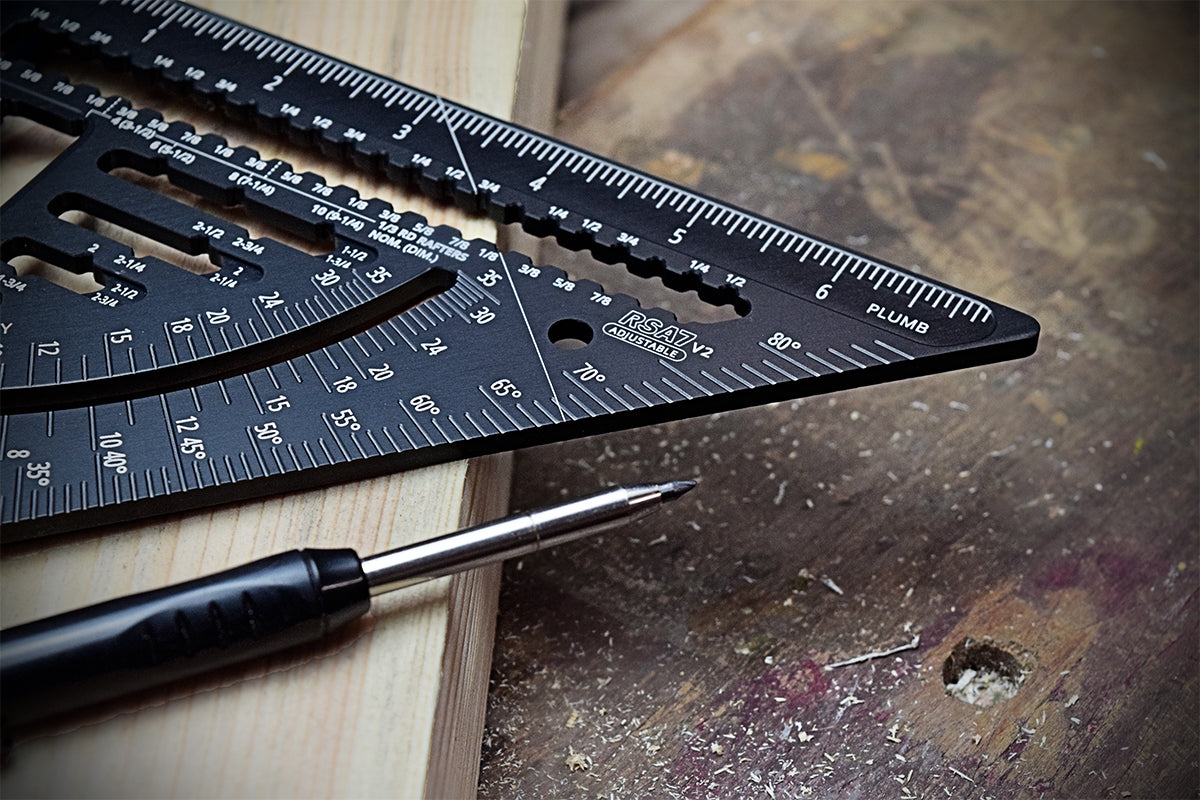
Which size speed square should I get?
You may have been wondering, what's the difference between a small and large rafter square and which is best for me? In this post we'll explain the different sizes of Rafter Squares, the main differences between them to help you choose the right one for you.

Rafter / Speed Square Sizes
Rafter squares typically come in 2 sizes - the highly popular 7 inch / 180mm and a larger 12 inch or 300mm version. Many tradespeople will opt for the smaller one of the two and find this is sufficient for most projects. This version such as our RSA180 Fixed and Adjustable squares provide several handy features such as:
- Marking angles and laying out lines
- Checking for squareness
- Finding roof or stairs pitch
- Guide saw cuts
- Scribing lines and parallels
- Drawing circles or finding the centre point
- Ripping boards
- Checking for square
- Quickly marking plumb and seat cuts and birds mouth
The advantages of a 7 inch or 180mm square is that they are versatile and fairly light and compact fitting into most tool belts and pouches. An Adjustable fence model such as the RSA180 Adjustable also helps you mark out repeat cuts quickly and easily e.g. when cutting multiple roof trusses or trim pieces.

The larger 12 inch / 300mm versions feature all of the above but with a blade that extends further from the fence and so is ideal for working with larger timbers. Many roofers carry both the small and the large rafter squares as timber dimensions can vary. However, most will agree that the large one is the one to get, due to increasing regulations on buildings - with more focus on the efficient heating of homes - extra thick insulation is often being called for. As such, we are seeing more larger rafters being used to accommodate thicker insulation. Naturally the larger square will allow you to reach further across the timber even when working on angles found on steep roof pitches. So there's no need to flip the square each time to mark one cut.
Our large RSA Rafter Squares are mighty tools, with a chunky fence they are easy to grip and wield, they share all the same features as their little brothers but with a longer ruler and more scribe notches, this is the king of all rafter squares. Of course they are heavier to carry around so very much depends on the type of projects you are working on.
What are the key differences between TrigJig Rafter Squares?
The RSA180 Fixed is a favourite for general trade use and traditional roofers. Tough enough to use in harsh conditions and small and light enough to carry on your person. They keep a fixed right angle and feature a handy spirit level in the fence for finding level, plumb and other angles. As above the larger RSA300 Fixed LE will give you that extra length and reach for working with big timber.

The RSA180 Adjustable is designed specifically for roofers. Allowing you to adjust and set the fence at your roof pitch so you can make quick, easy and repeatable plumb and seat marks on timber.

The larger RSA300 Adjustable is a much sort after upgrade to the small adjustable for working on larger pieces of timber.

What's the difference between cheap squares and premium squares?
"You get what you pay for" is a phrase commonly applied to tools and more often than not, it rings true. From personal and professional experience, cheap unbranded tools are poorly produced and often stamped from miscellaneous alloys they take seconds to make and cost pennies to produce. It's often said that you pay more for the storage and shipping than you do for the tool, you'll be hard pressed to find anything built to last or square at this end of the market.

Dan & Matt in the TrigJig workshop
Mid range tools made by well known companies, manufactured en masse, are what our grandparents might have considered "cheap" back in the day. With some quality control in place the squares can usually be square enough for the job. They are what should be the acceptable bare minimum in terms of quality. However, if you really want a high quality tool that's built to last. Or an innovative piece of British engineering built for accuracy in small batches from quality materials on British machinery then you need to look a little harder in this world of cheap mass production. Fortunately for you, TrigJig Tools may be the answer.
A wise man once said that quality is infectious, using tools that you know someone has made by hand the finesse is influential. You might not get that warm fuzzy feeling when your 20ft up in the air in the rain, squaring up a roof with your TrigJig Rafter Square, but everyone will know who is the boss.


Leave a comment